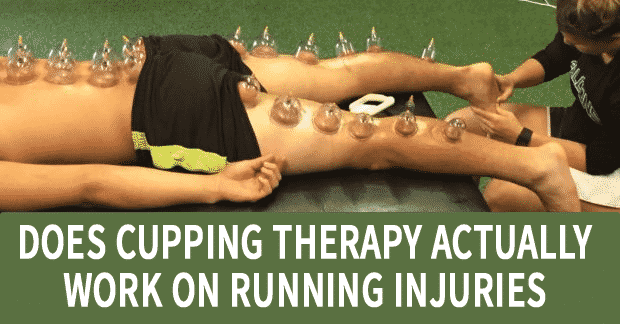If you watched the 2016 Olympics, it was hard to miss the large, circular welts and bruises on the backs, shoulders, and necks of many athletes.
Like with kinesiotape four years before, these marks—remnants of a therapeutic technique called cupping—were naturally suited for free promotion and buzz.
Cupping is one of the new hot trends in treating running injuries, but does it really work?
Cupping has a very long history; it’s been used since antiquity as a medical treatment for a huge variety of ailments.
The treatment is named as such because traditionally, it involves using cups and either a source of heat or vacuum to create suction inside the cup while it is placed facing down on the skin. Much like a “hickey,” this negative pressure causes tiny blood vessels near the skin, called capillaries, to burst, leaving the characteristic red or purple welts associated with the treatment.

How cupping works
The vacuum is applied to the cup either through mechanical suction, or more often, through heat. A match or an alcohol-soaked cotton swab is lit and allowed to burn inside the cup, then quickly extinguished as the cup is placed on the skin.
The hot air inside contracts as it cools, creating suction. In “wet cupping,” this is combined with small incisions into the skin which cause the suction to draw out blood.
Traditional sources claim that these can “draw out toxins” from the body, but the mainstream medical consensus is that the welts and bruises are simply the result of the bursting capillaries.
So, for all of this trouble, does cupping work?
Established medical authorities don’t seem to think so.
A 1988 paper by doctors at Ben-Gurion University in Israel detailed the history of cupping, deeming it an “irrational treatment” with no positive benefits and a definite risk of danger.1
Their article describes treating a woman who had suffered burns over 15% of her body when her cupping practitioner spilled flaming alcohol on the area he was supposed to be treating.
Other research published in the British Journal of Medicine and Medical Research also highlighted the potential side effects of cupping.2
Abdulla Mohammad Al-Bedah and other researchers conducted a review of studies and case reports on patients treated for cupping-related injuries, noting that scars and burns made up the majority of the adverse effects associated with the treatment.
They were more optimistic about the therapeutic potential of cupping, citing several case studies and small pilot studies that found some small benefit.
Research on cupping for treating injuries
In one example, researchers in Korea conducted a trial of cupping versus heating pads for neck pain.3
The researchers assigned 40 workers with occupation-related neck pain to either a cupping group or a heat pad therapy group. Each group received six treatment sessions spread out over two weeks, and were followed for an additional five weeks to evaluate neck function.
The researchers found that the cupping treatments were moderately more effective than the heating pads when it came to reducing pain and improving neck functionality, but it wasn’t without adverse effects—four of the 20 patients assigned to the cupping treatment had itching, lacerations at the cupping site, pain, and body aches. These disappeared within a few days.
Another trial on cupping for low back pain found more ambiguous results.
A 2011 study by researchers at Kyung Hee University in Korea treated 21 patients with wet cupping and compared their results with 11 patients who were still on a waiting list for treatment.4 This study design is problematic, as it provides a strong possibility for a placebo effect.
Still, even with this design, the study’s results were not particularly promising. Mild improvements were seen on a couple of indicators of pain and functionality, but several other measurements were equal between the groups.
Beyond small trials like this, there isn’t any evidence that cupping is an effective treatment for any illness or injury, much less sporting or running injuries.
This was the conclusion of a systematic review by researchers at the Korea Institute of Oriental Medicine.5
Mild evidence exists for the use of cupping to reduce pain, but even this is suspect, and the adverse effects should not be discounted.
Should you bother with cupping?
After considering the relatively weak evidence for cupping’s efficacy, combined with the relatively high rate of adverse effects, using cupping as a treatment for running injuries does not look like a good idea.
The underlying problem is that there isn’t a plausible mechanism for it to fix running injuries.
Even though there are plenty of treatments out there with similarly weak evidence in favor of them, like Active Release Technique or Graston Technique, at least these treatments have a plausible mechanism (breaking down scar tissue and muscle adhesions, in these cases) and no major side effects.
The same is not true for cupping.
In sum, despite the celebrity sports personality endorsements, cupping shouldn’t be at the top of your list of alternative treatments to try, even if you’ve got a stubborn running injury that isn’t healing.
There are a lot more promising treatment avenues out there that have a higher chance of working and a lower chance of causing problems.




One Response
Glad to hear the benefits are anything but promising. The after effects look insanely painful. And hard to explain to you non-athletic friends.